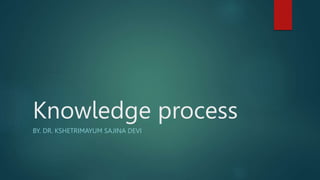
Knowledge process
- 1. Knowledge process BY. DR. KSHETRIMAYUM SAJINA DEVI
- 2. Different ways of knowing Any information about a place or thing is known as the knowledge of that particular entity. So, we can say that knowledge is knowing about someone or something. Knowledge is familiarity, awareness or understanding of someone or something such as facts, information, descriptions or skills, which is acquired through experience or education by perceiving, discovering or learning. The interaction of people in society generates knowledge, while developing knowledge means knowledge is based on previous experiences.
- 3. The Process of Knowing The process of knowing is explicate and explains to a large extent the meaning and also the nature of knowledge. Knowing happens through perception, reason, emotion, and codification. The valid ways of knowing are perception, reason, emotion, and language. All have a particular purpose and place. A child from infancy to early childhood relies heavily on the sense perception for knowledge acquisition. It is only after stepping into late childhood that the other three ways of knowing starts taking place. Language and emotions are followed by reason, and by adulthood, it is combination of all the four that converge in the process of knowledge acquisition.
- 4. Let us discuss about the ways of knowing in detail 1. Sense Perception It is the most basic and immediate way of knowing, but sometimes it might not be a very reliable source. The acquisition of knowledge begins with the reception of external stimuli by our sense organs, which is immediately converted into the form of perception. Thus, knowledge starts with the experience of the facts or matters through the sense organs, individually and collectively at the individual level or while participating in any social activity. The ultimate source of all human knowledge is the evidence of reality provided by the senses. All the five senses such as touch, taste, sight, smell, and hearing, contribute towards our quest for knowledge acquisition. They are sometimes referred to as the gateways of knowledge. Sensations are simple sensory experiences. Perceptions are complex constructions of simple elements joined through association. Perception is influenced by expectations, needs, unconscious ideas, values, conflicts, and past learning of a person. Sense perception is a subjective activity, and hence, it varies from individual-to-individualdepending upon one’s innate abilities. Our physical conditions, motivational dispositions, and mental state direct our sense perception. Perception is the process of attaining awareness or understanding of the environment by organising and interpreting sensory stimuli. It is shaped by learning, memory, and expectation.
- 5. 2. Language Language is a system of conventional, spoken, manual, or written symbols by means of which human beings, as members of a social group and participants in its culture express themselves. Language is the primary basis of all communication and the primary instrument of thought. Language is determined by a number of factors such as social background, attitudes, and origin of people. Language acts as a carrier or medium for conveying knowledge from one individual to the other. It integrates knowledge acquired through varied sources at varied places and names it. It helps in memorising and recalling. Language contributes to knowledge acquisition and transmission. Language is so much a part of human activity that it is easily taken for granted. The issues related to language and knowledge call for conscious scrutiny in order to recognise its influence on thought and behaviour.
- 6. 3. Reason The action of thinking about something in a logical, sensible way to form a conclusion or judgement is called reasoning. Developing rational and critical thinking abilities is pivotal to acquiring reliable knowledge. It involves both conscious and unconscious reasoning. Sometimes what has happened in the past teaches us to reason with reference to the future. Developing association between past, present, and future occurrences is part of the reasoning process creating patterns in the process of learning. In logic, we often refer to the two broad methods of reasoning, namely, deductive and inductive reasoning. Deductive reasoning works from the more general to the more specific. Sometimes this is informally called a ‘top-down approach’. Inductive reasoning works the other way, moving from specific observations to broader generalisations and theories. Informally, we sometimes call this a bottom-up approach
- 7. Emotion It is a strong feeling deriving from one’s circumstances, mood, and relationships with others. One of the ways of knowing is emotion. Emotions and their expression vary across cultures and hence, knowledge so acquired may not be as reliable. It is subjective and less measurable. It helps as well as hinders in the process of knowledge construction. The training of emotion is a key factor in enhancing the teaching-learning process. There are few ways by which students can be initiated into the process of knowing. They are by experiencing the situations themselves, by relating to previous knowledge, by dealing with problematic situations and developing rational, abstract knowledge, and by relating to real- life situations.